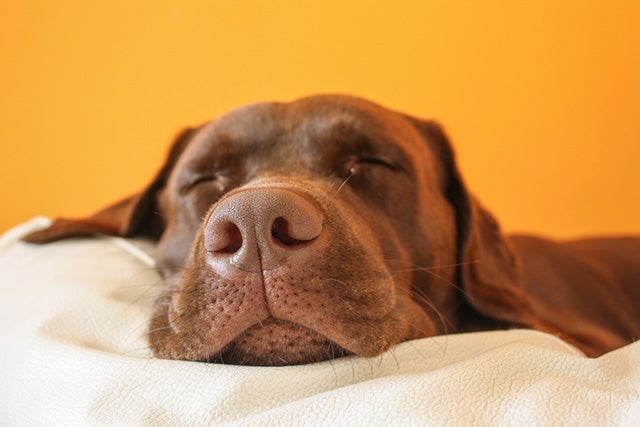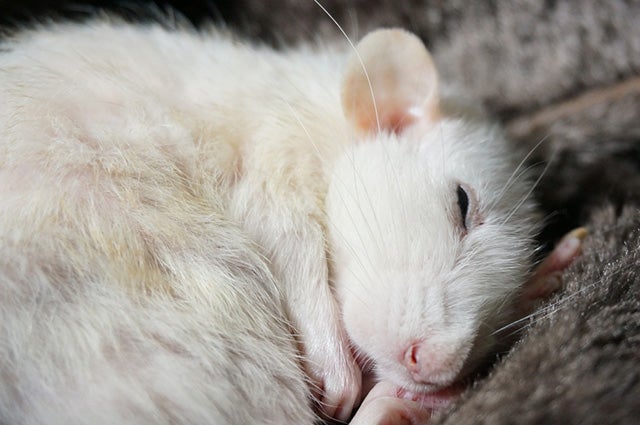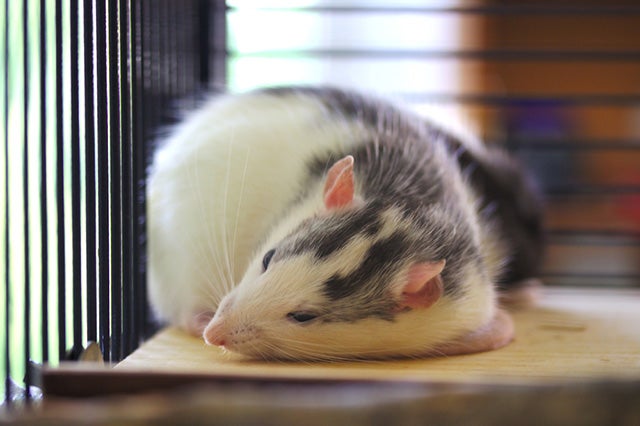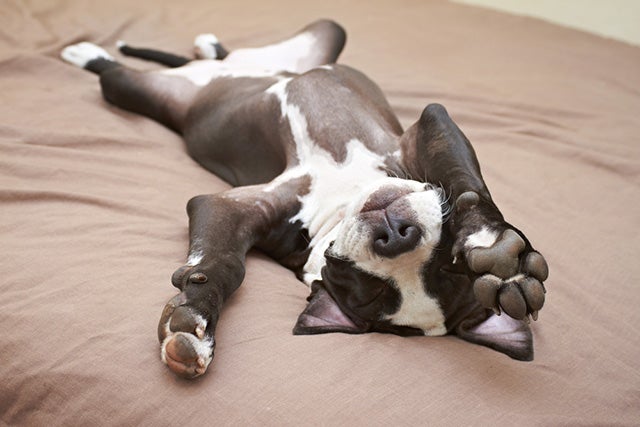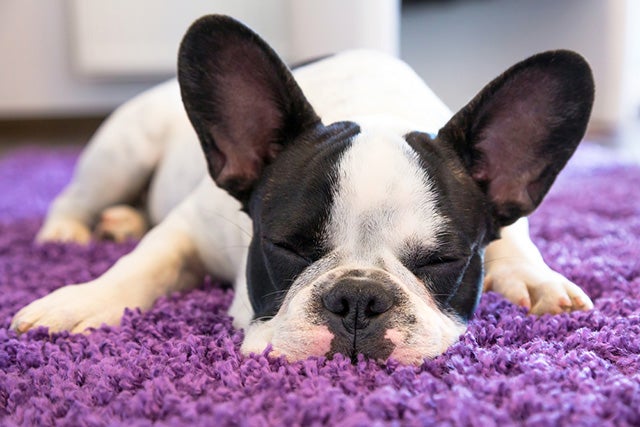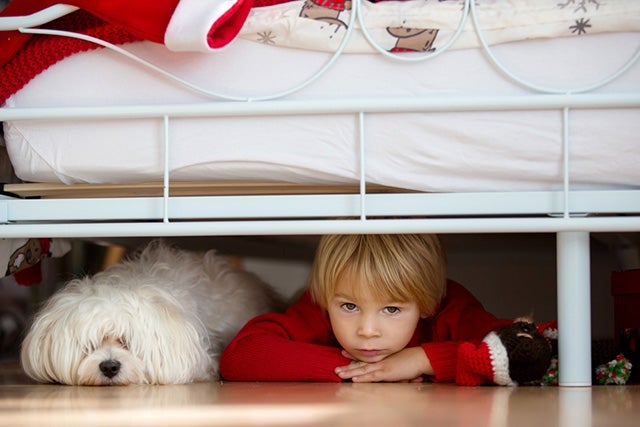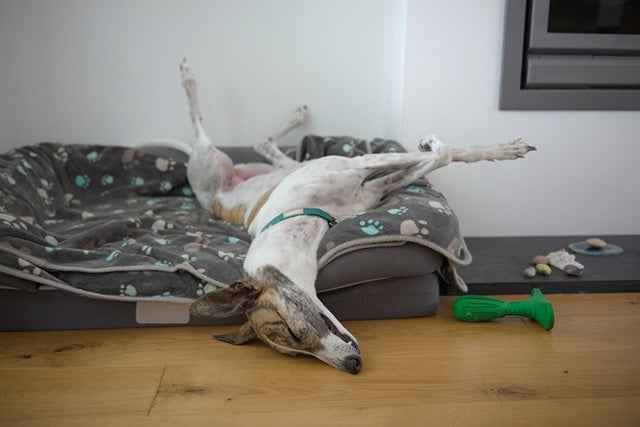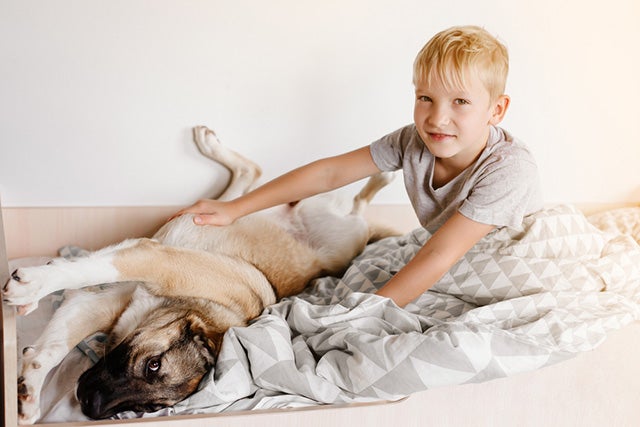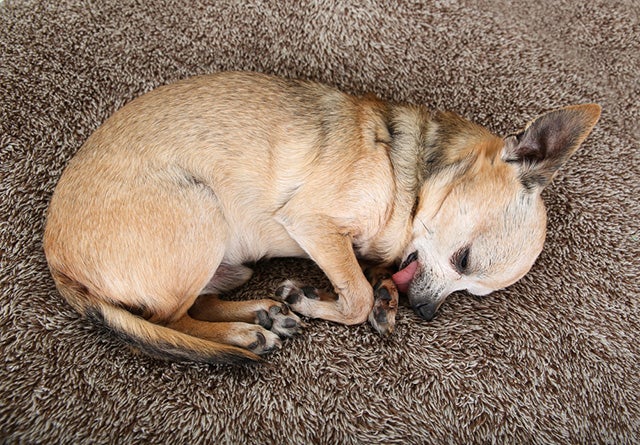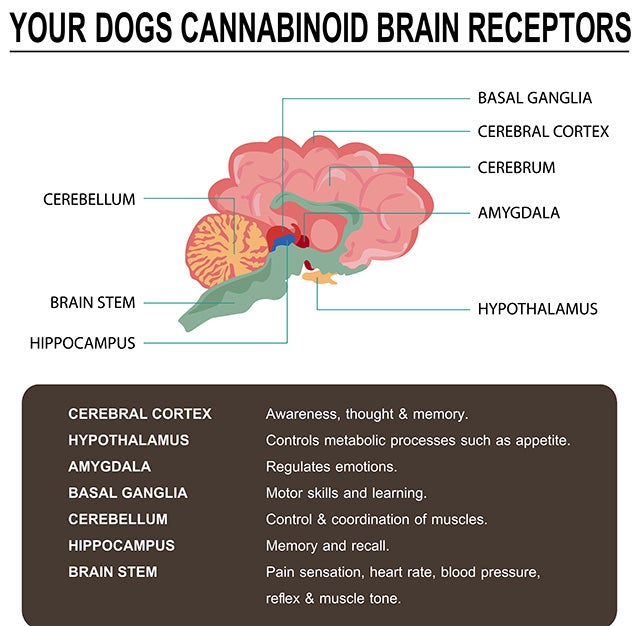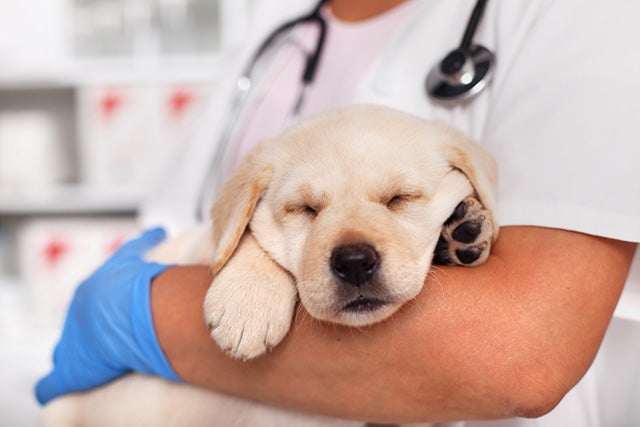Have you ever noticed your dog twitching its legs or whining in its sleep? Those might be signs that your dog is actually dreaming. If you’re curious about what makes your dog sleep better and whether or not they’re dreaming of you, read on to find out more.
Do Dogs Dream?
Numerous individuals believe that dogs are capable of dreaming. Most dog owners are aware that at certain points throughout their sleep, some dogs may shiver, make leg twitches, or even snarl or snap at some sleep-induced phantom.
Dogs’ brains are structurally similar to ours. Additionally, when dogs sleep, their brain wave patterns resemble those of people. They experience the same stages of electrical activity as humans, all of which are compatible with the hypothesis that dogs dream.
Indeed, if dogs did not dream, this would be a considerably greater surprise, considering that recent data reveals that animals (which are less complex and cognitive than dogs) dream.
The Massachusetts Institute of Technology’s Matthew Wilson and Kenway Louie have discovered that the brains of sleeping rats function in an irresistible way that resembles dreaming.
Research on Animal Dreams
Much of your nighttime dreaming is related to the activities you engaged in during the day. The same appears to be true for rats. Thus, if a rat runs a complex maze during the day, it is reasonable to assume that he will dream about it at night.
Electrical recordings from the hippocampus of a rat were made while it was awake and learning the maze.
The researchers discovered that certain of these electrical patterns were unique and identifiable based on the rat’s behavior.
Later, while the rats were sleeping and their brain waves suggested that they had entered the stage of dreaming commonly associated with humans, these identical brain wave patterns appeared.
The patterns were so distinct and exact that the researchers could predict where the rat would be in the maze if it were awake, as well as whether it would be standing still or moving.
Given the complexity of a dog’s brain and the similar electrical patterns, it is fair to believe that dogs dream as well. Additionally, there is evidence that they dream about typical canine behaviors.
This type of research makes use of the fact that everyone’s brainstem contains a unique feature that prevents them from acting on their dreams.
When scientists destroyed or inactivated the portion of the brain that prevents dogs from acting out their dreams, they found that the dogs began to wander around. This occurred even though affect. Since their electrical brain recordings suggested that they were still fast asleep.
The canines began to move only when the brain reached the dreaming stage of sleep. During a dream episode, these canines began to perform the acts shown in their dreams.
Are Dog’s Dreams Different from Ours?
According to Dr. Deirdre Barrett of Harvard University, canines are likely dreaming about their human caregivers. Barrett has spent years investigating human sleep habits. Although Barrett acknowledges that there is no way to know for definite what animals dream about, she may extrapolate from what she knows about humans.
One certainty is that the majority of mammals, including dogs, follow a similar sleep cycle to humans. They transition smoothly from deep sleep to a less brain-active state and subsequently to the stage of Rapid Eye Movement. In humans, this final part of the cycle is when dreams occur.
Humans dream about the same topics they are interested in during the day, but in a more visual and illogical fashion.
There is no reason to believe that animals are any different than humans. Given how close dogs are to their human owners, it’s likely that your dog dreams of your face, your fragrance, and of pleasing or irritating you.
How to Tell If Your Dog Is Dreaming
It is quite simple to identify whether your dog is dreaming. Simply keep an eye on him as he begins to doze off. The deeper the dog sleeps, the more regular his breathing gets.
After approximately 20 minutes, his first dream should begin if he is an average-sized dog. You will notice the change in his breathing pattern since it will become shallow and erratic.
There may be strange muscle spasms, and if you look closely enough, you can even see the dog’s eyes twitching behind its closed lids. This happens when he is staring at the dream visions as if they were real-world sights.
These eye movements are the most distinguishing feature of dreaming sleep. When humans are awoken during this REM sleep stage, they almost always report having dreamed.
Can Dogs Have Nightmares?
A Stanford University study discovered that dogs can suffer from narcolepsy. It’s reasonable to suppose that if this occurs, they also have nightmares. The American Kennel Club recommends against bothering your dog during what appears to be a nightmare.
Your dog may be confused and may exhibit hostile behavior against you. According to reports, 60 percent of dog bites in youngsters occur as a result of the child abruptly arousing the dog.
According to Dr. Barrett, the best method to prevent your dog from having nightmares is to make sure they live in a loving environment and have a healthy lifestyle. When your dog goes to sleep, he should enter the REM state with a head full of memories of fetching, eating treats, and receiving a good belly rub.
Finally, one study discovered that location is the strongest predictor of a good night’s sleep in canines. Dogs sleep better at home in a familiar location than they do in unfamiliar locations.
Therefore, if you want your dog to have positive dreams, ensure that they have a nightly routine and a specific place to call their own when it’s time to sleep.
The second most important predictor of a good night’s sleep is sufficient daytime activity. The more exercise your dog receives during the day, the better and longer he will sleep at night.
Nightmares vs. Seizures
The majority of individuals are unsure whether or not to awaken their dogs during a nightmare. While it’s terrible to witness your precious dog whining in their sleep, it’s critical to be kind when waking your pup from a nightmare.
If you notice your dog acting aggressively while sleeping, refrain from approaching too closely. Scaring them may result in an unintended nip. If you choose to awaken them, call them gently while standing further away rather than approaching them for a pat.
It’s all too common to confuse a dog seizure with a nightmare. The specialists at Purina tell us that the major differentiator between dog seizures and dog dreams is in the limbs.
For a brief period when dreaming, dogs may paddle or twitch their feet. When they have a seizure, though, the twitching may remain slightly longer and their limbs may become stiff and inflexible.
You might also notice foaming at the mouth or drooling at the mouth, which you should watch for if you have cause to believe your pooch is having a seizure.
Dog dreams are, on the whole, just as natural as human dreams. And, while we don’t know for certain what our four-legged friends dream about, we’ll choose to assume that dogs’ dreamland is filled with cuddly cuddles, long walks, and any extra food scraps they can find.
What Do Dogs Dream About?
The lives of the majority of dogs are more intriguing than those of rats. To ascertain what dogs might dream about, researchers conducted a test in which the pons was temporarily impaired.
The pons is a region of the brain stem that’s partly responsible for regulating your sleep cycles. It also aids in the inhibition of major muscular movement during sleep.
In other words, you may thank the pons for keeping you from acting out while you’re sleeping. Without the pons, people would act out their dreams, most likely with terrible outcomes.
Puppies and older dogs sleep with a lot of twitching and movement. According to Stanley Coren, a psychology professor at the University of British Columbia, this is because the pons is undeveloped in puppies and less efficient in adult canines. The same is true for infants and seniors.
Researchers discovered that temporarily disabling the pons during REM sleep is one method for determining what dogs dream about. This allowed them to allow the canines to act out their dreams under carefully monitored conditions.
They’ve discovered that dogs dream about doggie things. As a result, pointers will direct their attention to dream birds, and Dobermans will pursue dream burglars. Dogs’ dream patterns appear to be remarkably similar to those of humans.
Are Dreams Different From One Dog to Another?
For reasons still unknown, the dog’s size may have an effect on the magnitude of the dream. Experts explained that smaller dogs tend to have shorter but more frequent dreams, whereas larger dogs have fewer but longer dreams.
Due to the fact that dreams occur during rapid eye movement (REM) sleep, a dog’s circadian rhythm and sleeping patterns will influence how quickly they can reach the stage where dreams can begin.
A dog that rests regularly during the day may have fewer dreams simply because he never enters deep, REM slumber. Dogs that are light sleepers that spend the majority of their naptime in slow-wave sleep are unlikely to dream much.
A dog that does not nap and is capable of sleeping through the night has a higher probability of having a vivid dream. Similarly, dogs that work all day may fall into a deeper slumber more rapidly, allowing them more opportunity to dream about their day’s activities.
Can We Influence a Dog’s Dreams?
According to Lisa Radosta, a board-certified veterinary behaviorist with Florida Veterinary Behavior Service, it’s important that we set up dog sanctuaries in our homes.
A sanctuary space is an area apart from the main living area in which the pet can unwind. It should be familiar and pleasant for the pet.
Many dog owners find it disturbing when their dog leaves the room, but they shouldn’t be offended by this behavior. It simply means that the dog needs a break.
Playing gentle music and minimizing abrupt stimuli, such as a loud television show, can also help our pets sleep. However, some dogs will sleep through a thunderstorm. That’s why you need to get to know your dog better to understand their preferences and behavior.
If dogs replay daily events in their dreams and utilize sleep to process social interactions, this provides another strong reason to employ positive training techniques rather than punishment-based techniques.
To improve our dogs’ life and provide them with nice dreams rather than frightening nightmares, consider the following tips:
- Consider what your dog truly enjoys doing and emulate it.
- Concentrate on the positive. Rather than wasting your day attempting to figure out how to discipline your dog, spend your time rewarding them for good behavior.
- Allow him to be who he is. Accept your dog for who he is first, and then look for activities you can enjoy together.
- Keep your dog occupied. Maintain his interest with toys and the occasional treats.
- Allow your dog to rest. Everyone, including pets, requires somewhere to unwind.
Conclusion
It would seem that when your dog dreams, they’re most likely dreaming about you. As research suggests, you can actually ensure your dog has the most pleasant dreams when they sleep in a familiar place, lead a healthy lifestyle, and get plenty of exercise during the day. Want more great tips and info like this? Check out our guide to insomnia!
Photo credit: johncan/Shutterstock; Sigma_S/Shutterstock;
Neil Lockhart/Shutterstock; JLRphotography/Shutterstock;
fongleon356/Shutterstock; Lauredin/Shutterstock;
Patryk Kosmider/Shutterstock; dogboxstudio/Shutterstock;
Tomsickova Tatyana/Shutterstock; Rhys Leonard/Shutterstock;
LenaLavr/Shutterstock; srw-photo/Shutterstock;
Ilike/Shutterstock; WuttikitStudio/Shutterstock;
Annette Shaff/Shutterstock;
